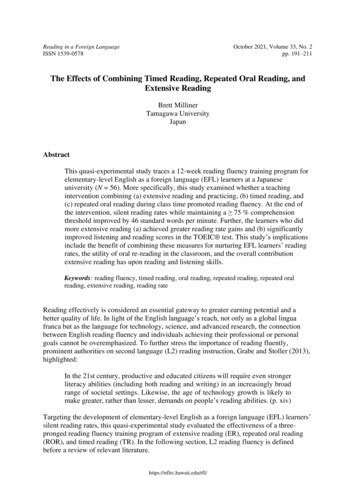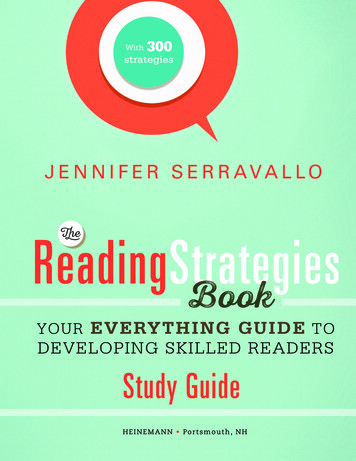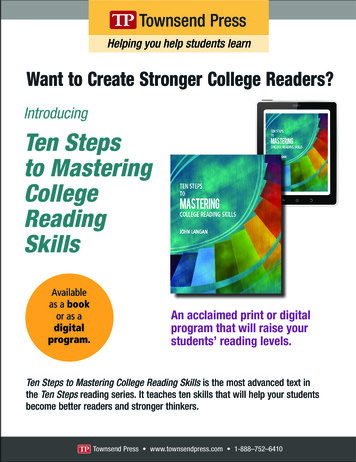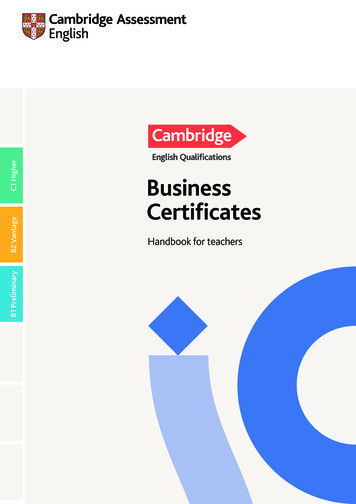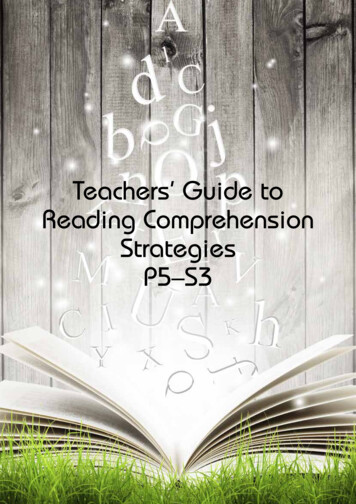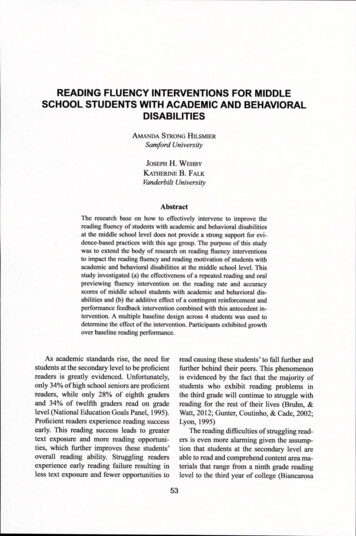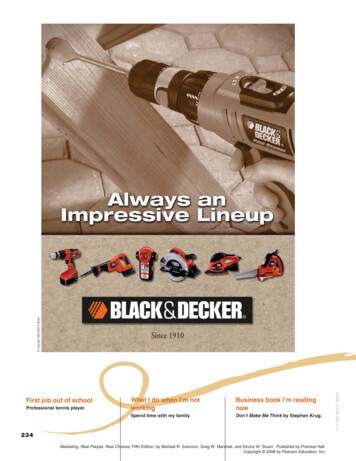
Transcription
Copyright 2005 Black & DeckerProfessional tennis player.What I do when I’m notworkingBusiness book I’m readingnowSpend time with my family.Don’t Make Me Think by Stephen Krug.234Marketing: Real People, Real Choices, Fifth Edition, by Michael R. Solomon, Greg W. Marshall, and Elnora W. Stuart. Published by Prentice Hall.Copyright 2008 by Pearson Education, Inc.ISBN: 0-536-48410-4First job out of school
8PA R T I I I : C r e a t i n g t h e Va l u e P r o p o s i t i o nCreating the Productreal people, real choicesISBN: 0-536-48410-4Meet Eleni Rossides, a Decision Maker at Black &DeckerEleni Rossides is senior manager of business development in the Black & Decker Consumer Group of TheBlack & Decker Corporation, a leading manufacturer ofpower tools, outdoor power equipment, and householdcleaning equipment. After attending Stanford Universityon a tennis scholarship, she graduated with a degree incommunications and then competed on the women’sprofessional tennis tour. In 2001, she received herM.B.A. from Northwestern University, where she did amarketing internship at Johnson & Johnson. After graduating, she accepted a consulting position at McKinseyand Co. Since coming to Black & Decker in 2003, herresponsibilities have included developing marketresearch/marketing strategy for all the company’s businesses. She recently left Black & Decker to becomeExecutive Director of the Washington Tennis &Education Foundation.What drives meTo improve.Don’t do this wheninterviewing with meMy pet peeveUntrustworthy people.Be unprepared.235Marketing: Real People, Real Choices, Fifth Edition, by Michael R. Solomon, Greg W. Marshall, and Elnora W. Stuart. Published by Prentice Hall.Copyright 2008 by Pearson Education, Inc.
Decision Time atBlack & Decker236PART THREEOption 1 Don’t fix it if it ain’t broke.Keep the ScumBuster as it is. Although the initial allure ofthe product had worn off, Black & Decker continued to sellScumBusters without spending a lot to promote them.Survey respondents said that overall they were quite satisfied with the product. The product-development teamcould focus its attention on creating new devices to meetother household needs. On the other hand, it wasn’t clearhow long the ScumBuster would continue to “rest on itslaurels” now that competing brands were starting to challenge its dominance in the category. Eventually, Black &Decker would not sell enough ScumBusters to justify theirplace on store shelves, and it would have to walk awayfrom the business.Option 2 Emphasize value for your money.The survey showed that by far the ScumBuster’s primary usewas to clean shower tubs and walls. Therefore, Black &Decker could remove all the accessories except those that areused for tub and tile cleaning and in the process lower theprice of the appliance. This price/value strategy might enableBlack & Decker to accelerate sales of a stripped-down, taskfocused ScumBuster. And the survey showed that about 15percent of respondents received the product as a gift, so having a more reasonable offering might also encourage othersto give ScumBusters as gifts. On the other hand, people didseem to like the ScumBuster’s versatility (even if they didn’talways take advantage of its other potential uses). If Black &Decker focused only on tub/shower applications, the company might leave the market wide open to competitors thatoffered cleaning solutions for other areas such as kitchencounters or car detailing.Option 3 Ramp up the ScumBuster’s features.Give consumers what they said they wanted to make theircleaning chores easier and faster: variable speed, new attachments for hard-to-reach places, and an onboard liquid cleaning system. This would allow Black & Decker to introduce anew “loaded” version of its product to meet the competitionand give the company a reason to promote it more heavily.Of course, Black & Decker ran the risk of “preaching to theconverted,” since its research showed that most people werealready reasonably happy with the current version.Now, put yourself in Eleni’s shoes: Which optionwould you choose, and why?CREATING THE VALUE PROPOSITIONMarketing: Real People, Real Choices, Fifth Edition, by Michael R. Solomon, Greg W. Marshall, and Elnora W. Stuart. Published by Prentice Hall.Copyright 2008 by Pearson Education, Inc.ISBN: 0-536-48410-4Black & Decker sells a line of householdcleaning products that includes theDustBuster cordlessvacuum,theSteamBuster wet/dry vacuum, and theScumBuster cordless wet scrubber. The ScumBuster canbe used to clean many surfaces, such as tub and showerwalls, barbecue grills, dishes, and even car exteriors. It hasbeen popular for almost a decade because of its uniquenessand the lack of similar products available to consumers.Over time, however, the ScumBuster had started to take aback seat as Black & Decker focused its efforts on promoting newer products. In addition, competitors finally startedto enter the market with similar devices that also boastedother features, such as a power-operated brush.If Black & Decker was going to continue to be a leaderin this category, the company needed to develop a new andimproved ScumBuster—but preferably one that would notcost much more at retail to enable Black & Decker to maintain its profit margin on this product. In order to do that, Eleniand her colleagues needed to learn more about who was buying the ScumBuster so that Black & Decker would know howbest to promote and package the product. They also wondered which specific features people would find most valuableif Black & Decker decided to redo the product’s design. Infocus groups, for example, people said it was important to gettheir cleaning jobs done faster. They were enthusiastic aboutideas for new features, such as a liquid dispenser that includeda reservoir to hold a cleaning solution that would make theScumBuster a more convenient all-in-one system.Eleni knew that it is risky to base important decisions onthe comments of a few people in focus groups. She decided tocommission a survey of ScumBuster users in order to learn moreabout what they liked or disliked about the product and whichfeatures they might like to see added to it. Working withMind/Share, Inc., a marketing research firm based in Atlantathat specializes in Internet-based surveys, Eleni and her colleagues designed a survey in 2003. Along with product managerChristina Hamilton, she recruited 355 registered ScumBusterowners to respond to questions from their home computers.They answered questions about their cleaning needs, their reasons for buying the ScumBuster, their favorite accessories (suchas a scrubbing pad, an area brush, or a shampoo brush), andhow they typically used the ScumBuster (for example, in ashower or tub, on a grill, or to clean the inside of a car).The owners also were given a list of benefits such asrun time, ease of changing accessories, and rotation speed.They were asked to tell Black & Decker how importanteach was to them and also how satisfied they were withtheir ScumBuster product on each of these dimensions. Inaddition, they were given a list of features that might beadded (such as variable speed control, an extension handle,and disposable batteries). They were asked to say which (ifany) they would most like to see on a ScumBuster.Survey participants told Black & Decker that powerwas the most important reason leading to their choice of theScumBuster over competitors. They also recommended additional improvements to the product, including variablespeed, a contouring head, an extendable handle, and a powerscrub with a liquid cleaner. But it wasn’t clear that they werenecessarily willing to pay a lot more for these extra features.The survey found that one of the main reasons for choosingthe ScumBuster was price/value. Furthermore, many of theusers reported that they rarely or never used some of theaccessories that came with the ScumBuster they currentlyowned. Based on the feedback she got from this survey,Black & Decker had the following options:
O BJ ECTIV ESWhen you finish reading this chapter, you will be able to:1 Explain the layers of a product.2 Describe the classifications of products.3 Understand the importance of new products.4 Show how firms develop new products.5 Explain the process of product adoption and the diffusion ofinnovations.ISBN: 0-536-48410-4Build a Better Mousetrap: The ValueProposition“Build a better mousetrap and the world will beat a path to your door.” Although we’veall heard that adage, the truth is that just because a product is better is no guarantee it willsucceed. For decades, the Woodstream Company (under the brand name “Victor”) builtwooden mousetraps. Then the company decided to build a better one. Woodstream’sproduct-development people researched eating, crawling, and resting habits of mice (hey,it’s a living . . .). They built prototypes of different mousetraps to come up with the bestpossible design and tested them in homes. Then the company unveiled the sleek-looking“Little Champ,” a black plastic miniature inverted bathtub with a hole. When the mousewent in and ate the bait, a spring snapped upward, and the mouse was history.Sounds like a great new product (unless you’re a mouse), but the Little Champ failed.Woodstream studied mouse habits, not consumer preferences. The company later discovered that husbands set the trap at night, but wives were left in the morning to dispose of thetrap holding the dead mouse. Unfortunately, wives thought the Little Champ looked tooexpensive to throw away, so they felt they should empty the trap for reuse. This was a taskmost women weren’t willing to do—they wanted a trap they could happily throw away.1Woodstream’s failure in the “rat race” underscores the importance of creating productsthat provide benefits that people seek. It also tells us that any number of products, fromlow-tech cheese to high-tech traps, potentially deliver these benefits. Despite Victor’sclaim to be the “World’s Leader in Rodent Control Solutions,” in this case cheese and ashoe box could trap a mouse as well as a high-tech trap.We need to take a close look at how products successfully trap consumers’ dollars.Chapter 1 showed us that the value proposition is the consumer’s perception of the benefits she will receive if she buys a good or service. So, the marketer’s task is twofold: First,to create a better value than what’s out there already and then to convince customers thatthis is true.As we defined it in Chapter 1, a product is a tangible good, service, idea, or some combination of these that satisfies consumer or business customer needs through the exchangeprocess; a bundle of attributes including features, functions, benefits, and uses. Productscan be physical goods, services, ideas, people, or places. A good may be a pack of cookies,a digital camera, a house, a fancy new computer, or a pair of stone-washed jeans. A goodis a tangible product, something that we can see, touch, smell, hear, taste, or possess. Incontrast, intangible products—services, ideas, people, places—are products that we can’talways see, touch, taste, smell, or possess. We’ll talk more about intangible products inChapter 10.Marketers think of the product as more than just a thing that comes in a package. Theyview a product as a bundle of attributes that includes the packaging, brand name, benefits, and supporting features in addition to a physical good. Figure 8.1 reminds us that weare now in Part 3 of this book, “Creating the Value Proposition.” The key word here iscreating, and a large part of the marketer’s role in creating the value proposition is developing and marketing products appropriately. In this chapter, we’ll first examine what aproduct is and see how marketers classify consumer and business-to-business products.Then we’ll go on to look at new products, how marketers develop new products, and howCHAPTER 8goodA tangible product that we can see,touch, smell, hear, or taste.CREATING THE PRODUCTMarketing: Real People, Real Choices, Fifth Edition, by Michael R. Solomon, Greg W. Marshall, and Elnora W. Stuart. Published by Prentice Hall.Copyright 2008 by Pearson Education, Inc.237
Figure 8.1 Making andDelivering ValueMaking Marketing Value Decisions(Part 1)Understanding Consumers’ Value Needs(Part 2)Creating the Value Proposition(Part 3)Communicating the Value Proposition(Part 4)Delivering the Value Proposition(Part 5)markets accept them. In the chapters that follow, we’ll look at issues such as managingand pricing goods and services.Layers of the Product ConceptNo doubt you’ve heard someone say, “It’s the thought, not the gift that counts.” Thismeans that the gift is a sign or symbol that the gift giver has remembered you. When weevaluate a gift, we may consider the following: Was the gift presented with a flourish?Was it wrapped in special paper? Was it obviously a “re-gift”—something the gift giverhad received as a gift for himself but wanted to pass on to me? These dimensions are apart of the total gift you receive in addition to the actual goodie sitting in the box.Like a gift, a product is everything that a customer receives in an exchange. As Figure8.2 shows, we distinguish among three distinct layers of the product—the core product,the actual product, and the augmented product. In developing product strategies, marketers need to consider how to satisfy customers’ wants and needs at each of these threelayers. Let’s consider each layer in turn.The Core Productcore productAll the benefits the product will providefor consumers or business customers.PART THREECREATING THE VALUE PROPOSITIONMarketing: Real People, Real Choices, Fifth Edition, by Michael R. Solomon, Greg W. Marshall, and Elnora W. Stuart. Published by Prentice Hall.Copyright 2008 by Pearson Education, Inc.ISBN: 0-536-48410-4238The core product consists of all the benefits the product will provide for consumers orbusiness customers. As we noted in Chapter 1, a benefit is an outcome that the customerreceives from owning or using a product. Wise old marketers (and some young ones, too)will tell you, “A marketer may make and sell a half-inch drill bit, but a customer buys ahalf-inch hole.” This timeworn saying tells us that people are buying the core product, inthis case, the ability to make a hole. If a new product such as a laser comes along that provides that outcome in a better way or more cheaply, the drill-bit maker has a problem.The moral of this story? Marketing is about supplying benefits, not products. Table 8.1shows how some marketers rigorously test their products “in action” to be sure theydeliver the benefits they promise.Many products actually provide multiple benefits. For example, the primary benefit ofa car is transportation—all cars (in good repair) provide the ability to travel from point Ato point B. But products also provide customized benefits—benefits customers receivebecause manufacturers have added “bells and whistles” to win customers. Different drivers seek different customized benefits in a car. Some want economical transportation;
The ProductAutomobileBasic BenefitsTransportationCarrying cargoExcitementImage enhancementCore ProductFeaturesPackageBrandQualityAppearanceActual ProductAugmented ProductWarrantyRepair/maintenance service after the saleInstallationCustomer support servicesDeliveryCreditProduct-use instructionFigure 8.2Engine sizeColorInterior designBody sizeBody styleOptions availableModel name (Camry, Corolla, etc.)Workmanship4-year, 50,000-mile, bumper-to-bumper warrantyDealer parts and repair departmentDealer preparation prior to deliveryOwner instruction manual2.9% interest auto loanToll-free customer complaint numberCustomer problem policiesFree lubrication and oil changesLayers of the ProductA product is everything a customer receives—the basic benefits, the physical product and its packaging, and the“extras” that come with the product.others want a top-of-the-line, all-terrain vehicle; and still others look for a hot car thatwill be the envy of their friends.The Actual ProductThe second layer—the actual product—is the physical good or the delivered service thatsupplies the desired benefit. For example, when you buy a washing machine, the coreproduct is the ability to get clothes clean, but the actual product is a large, square, metalapparatus. When you get a medical exam, the core product is maintaining your health,but the actual product is a lot of annoying poking and prodding. The actual product alsoincludes the unique features of the product, such as its appearance or styling, the package,and the brand name. Canon makes a wide range of cameras, from inexpensive, disposablecameras to expensive digital models that do everything but take the photo for you—alloffering the same core benefit of recording a person or event on film or in a digital format.actual productThe physical good or the deliveredservice that supplies the desired benefit.ISBN: 0-536-48410-4The Augmented ProductFinally, marketers offer customers an augmented product—the actual product plus othersupporting features such as a warranty, credit, delivery, installation, and repair serviceafter the sale. Marketers know that adding these supporting features to a product is aneffective way for a company to stand out from the crowd.For example, Netflix provides rental of DVDs (the actual product) to customers whowant access to entertainment (the core product). Netflix successfully competes withvideo/DVD rental stores by letting customers rent an unlimited number of DVDs, withthree movies out at a time, for a monthly subscription fee of around 20. Unlike rentingCHAPTER 8augmented productThe actual product plus other supportingfeatures such as a warranty, credit,delivery, installation, and repair serviceafter the sale.CREATING THE PRODUCTMarketing: Real People, Real Choices, Fifth Edition, by Michael R. Solomon, Greg W. Marshall, and Elnora W. Stuart. Published by Prentice Hall.Copyright 2008 by Pearson Education, Inc.239
Table 8.1Product TestingProductTesting ProcedureBenefitLouis VuittonhandbagsA mechanical arm lifts a handbag,loaded with an eight-pound weight,1.5 feet off the floor, and then dropsit over and over again, for four days.An attractive yet durablehandbagChrysler carsCars face gale-force, blizzardconditions (snow included). If thecar passes that test, it is subjectedto simulated desert heat the nextday.Reliable transportation evenunder the worst weatherconditionsSherwin-Williamspaint40,000 panels, painted with bothSherwin-Williams and competitors’paints, are subjected to the weatherfor up to 15 years (the length ofthe warranty on some paint).A house paint that remainsattractive throughout thewarranty periodApple computersTo simulate real-life conditions,computers are drenched withsoda, smeared with mayonnaise,and baked in ovens (to mimic thetrunk of a car in the summer heat).Computing power that isimpervious to normal wearand tear—and moreMattel’s BarbieQuality testers yank and pullBarbie’s hair and limbs to makesure she can withstand the stronghands and teeth of five-year-olds.They pour sand on her and bakeher in simulated sunlight. OnlyBarbies that pass the tensilestrength, UV, heat, and salivatests are accepted.A toy that is both fun andsafe for childrenShaw Industriescarpet productsWorkers pace up and down rows ofcarpet samples eight hours a day.One worker reads three books aweek and has lost 40 pounds inthree years as a carpet walker.Carpeting that is attractiveand durable after years ofwearOtis elevatorsElevator components are strappedto a vibrating “shaker table,” thensubjected to heat reaching 400degrees Fahrenheit and as cold as–150 degrees Fahrenheit.An elevator that provides asmooth, safe ride and canwithstand extreme conditions(such as a lightning strike)Procter & Gamblehair care productsP&G pays over 1,000 formannequin heads with realistichair for testing new hair careproducts. Each of P&G’s 15 “heads”has a name. When the hair beginsto get thin, the “head” is retired.Attractive, healthy hairSources: Otis Research Center, “Shaking, Baking and Proving Technology,” August 27, 2003, http://home.fuse.net/mllwyd/barbie misc.html: Faye Rice, “Secrets of Product Testing,” Fortune, November 28, 1994, 166–72;www.utc.com/press/highlights/ 2003-08-27 tower.htm; and Carol Matlack, “The Vuitton Machine,” BusinessWeek, March 22,2004, 98–102.240PART THREECREATING THE VALUE PROPOSITIONMarketing: Real People, Real Choices, Fifth Edition, by Michael R. Solomon, Greg W. Marshall, and Elnora W. Stuart. Published by Prentice Hall.Copyright 2008 by Pearson Education, Inc.ISBN: 0-536-48410-4from a video store, customers can keep the movies as long as they want with no late fees.Customers pay no shipping fees in either direction, and they can choose from 20,000titles—a much more extensive collection than what the largest movie-rental stores canoffer. Netflix also offers a movie recommendation service based on each customer’s ratingof previous movies. Netflix’s augmented product (free shipping, no time limits, extensiveselection, and targeted recommendation) has paid off for the company, which reached 1
billion in revenues by 2005. Stockholders have also done well: The stock price has continued to grow at double or triple digits every year in this decade. However, competitionis on the horizon from Blockbuster and others.2Classifying ProductsSo far we’ve learned that a product may be a tangible good or an intangible service or ideaand that there are different layers to the product. Now we’ll build on that idea by lookingat how products differ from one another. Marketers classify products into categoriesbecause the categories represent differences in how consumers and business customers feelabout products and how they purchase different products. Such an understanding helpsmarketers develop new products and a marketing mix that satisfies customer needs. Table8.2 summarizes these categories.Table 8.2Classification of ProductsMarketers classify products as a means of better understanding how consumers make purchasedecisions.Consumer ProductsClassified by how long they lastDurable: products that provide a benefit over a long period Example: RefrigeratorNondurable: products that provide a benefit over a short time Example: ToothpasteClassified by how consumers buy themConvenience Products: products that are frequently purchased with little effort Examples: Staples (milk)Impulse products (candy bars)Emergency products (drain opener)Shopping Products: products that are selected with considerable time and effort Examples: Attribute-based (shoes)Price-based (water heater)Specialty Products: products that have unique characteristics to the buyer Examples: Favorite restaurant, Rolex watchUnsought Products: products that consumers have little interest in until need arises Example: Retirement plansISBN: 0-536-48410-4Business-to-Business ProductsClassified by how organizational customers use themEquipment Examples: Capital equipment (buildings)Accessory equipment (computer terminals)Maintenance, Repair, and Operating (MRO) Products Examples: Maintenance products (lightbulbs, mops)Repair products (nuts, bolts)Operating supplies (paper, oil)Raw Materials Example: Iron oreProcessed Materials Example: Sheets of steelSpecialized Services Example: Legal servicesComponent Parts Example: Car water pumpCHAPTER 8CREATING THE PRODUCTMarketing: Real People, Real Choices, Fifth Edition, by Michael R. Solomon, Greg W. Marshall, and Elnora W. Stuart. Published by Prentice Hall.Copyright 2008 by Pearson Education, Inc.241
Generally, products are either consumer products or business-to-business products,although sometimes consumers and businesses buy the same products, such as toiletpaper, vacuum cleaners, and lightbulbs. In these cases, though, businesses tend to buy alot more of them at once. Of course, as we saw in Chapters 5 and 6, customers differ inhow they decide on a purchase, depending on whether the decision maker is a consumeror a business purchaser. Let’s first consider differences in consumer products based onhow long the product will last and on how the consumer shops for the product. Then wewill discuss the general types of business-to-business products.Classifying Goods: How Long Does the Product Last?durable goodsConsumer products that provide benefitsover a long period of time, such as cars,furniture, and appliances.nondurable goodsConsumer products that provide benefitsfor a short time because they areconsumed (such as food) or are nolonger useful (such as newspapers).Marketers classify consumer goods as durable or nondurable depending on how long theproduct lasts. You expect a refrigerator to last many years, but a gallon of milk will lastonly a week or so until it turns into a science project. Durable goods are consumer products that provide benefits over a period of months, years, or even decades, such as cars,furniture, and appliances. In contrast, we consume nondurable goods, such as newspapersand food, in the short term.We are more likely to purchase durable goods under conditions of high involvement (aswe saw in Chapter 5), while nondurable goods are more likely to be low involvementdecisions. When consumers buy a computer or a house, they will spend a lot of time andenergy on the decision process. When they offer these products, marketers need to understand consumers’ desires for different product benefits and the importance of warranties,service, and customer support. So they must be sure that consumers can find the information they need. One way to do this is by providing a “Frequently Asked Questions”(FAQs) section on a company Web site. Another way is to host a message board or blogto facilitate a sense of community around the product. When a company itself sponsorssuch forums, odds are the content will be much more favorable and the firm can policeperipheral postings. For example, the section of the Microsoft Web site called “MicrosoftTechnical Communities” allows users to problem-solve by typing in any product (or evenan error code that popped up on your computer) and then to track through a discussionboard on that issue.3In contrast, consumers usually don’t “sweat the details” so much when choosingamong nondurable goods. There is little if any search for information or deliberation.Sometimes this means that consumers buy whatever brand is available and reasonablypriced. In other instances, they base their decisions largely on past experience. Because acertain brand has performed satisfactorily before, customers see no reason to considerother brands, and they choose the same one out of habit. For example, some consumersbuy that familiar orange box of Tide laundry detergent again and again. In such cases,marketers can probably be less concerned with developing new product features to attractcustomers; they should focus more on pricing and distribution strategies.Classifying Goods: How Do Consumers Buy the Product?Marketers also classify products based on where and how consumers buy the product. Wecan think of both goods and services as convenience products, shopping products, specialty products, or unsought products. Recall that, in Chapter 5, we talked about howconsumer decisions differ in terms of effort from habitual decision making to limitedproblem solving to extended problem solving. We can tie this classification of products interms of how consumers buy them to these differences in consumer decision making. Byunderstanding how consumers buy products, marketers have a clearer vision of the buying process that will help them to develop effective marketing strategies based on the category into which their product falls.242PART THREECONVENIENCE PRODUCTS A convenience product typically is a nondurable goodor service that consumers purchase frequently with a minimum of comparison and effort.As the name implies, consumers expect these products to be handy and they will buywhatever brands are easy to obtain. In general, convenience products are low-priced andwidely available. You can buy a gallon of milk or a loaf of bread at grocery stores, at con-CREATING THE VALUE PROPOSITIONMarketing: Real People, Real Choices, Fifth Edition, by Michael R. Solomon, Greg W. Marshall, and Elnora W. Stuart. Published by Prentice Hall.Copyright 2008 by Pearson Education, Inc.ISBN: 0-536-48410-4convenience productA consumer good or service that isusually low-priced, widely available, andpurchased frequently with a minimum ofcomparison and effort.
ISBN: 0-536-48410-4venience stores, and even at many service stations. Consumers generally know all theyneed or want to know about a convenience product, devote little effort to purchases, andwillingly accept alternative brands if their preferred brand is not available in a convenientlocation. Most convenience product purchases are the results of habitual consumer decision making. What’s the most important thing for marketers of convenience products?You guessed it—make sure the product is easily obtainable in all the places where consumers are likely to look for it.But all convenience product purchases aren’t alike. You may stop by a local market onyour way home from school or work to pick up that gallon of milk because milk is something you always keep in the refrigerator. As long as you’re there, why not grab a candybar for the drive home? Later that night, you dash out to buy something to unclog yourkitchen drain—also a convenience product. Marketers classify convenience products asstaples, impulse products, and emergency products.Staples such as milk, bread, and gasoline are basic or necessary items that are availablealmost everywhere. Most consumers don’t perceive big differences among brands. Whenselling staples, marketers must offer customers a product that consistently meets theirexpectations for quality and make sure it is available at a price comparable to the competition’s prices.Consider this situation: You
Black & Decker Black & Decker sells a line of household cleaning products that includes the DustBuster cordless vacuum, the SteamBuster wet/dry vacuum, and the ScumBuster cordless wet scrubber. The ScumBuster can be used to clean many surfaces, such as tub and shower walls




